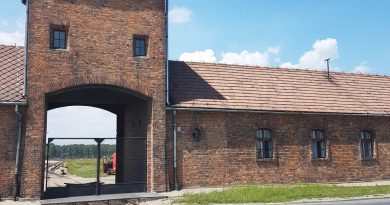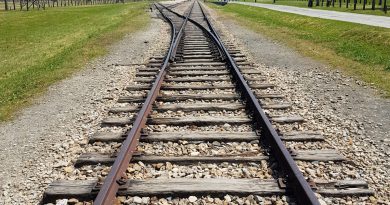Oświęcim – Auschwitz-Birkenau Concentration Camp
I visited Auschwitz-Birkenau just over four years ago, in 2016, which pre-dates this blog. I’ve never wanted to re-visit the camp, although it’s somewhere that perhaps in an ideal world that everyone would want to go and see, to understand what happened here.
I’ll put more photos up over the next few days in separate posts, but there are three I took that day that are the most memorable to me.
This is a replacement sign as the original one was stolen in 2009. It was recovered, albeit cut into three pieces, but the replacement was left up and the original is now in the camp’s museum. It’s at the entrance to Auschwitz (Auschwitz and Birkenau are two different camps, but are nearby and are grouped together) and it’s one of the first things that visitors see. I had deliberately arrived early on in the morning as I didn’t want to go around in a guided tour, I preferred to walk around on my own. So, there were relatively few people around at this time and the camp felt quiet and still.
This is the railway line that led into Birkenau, the right-hand side is the ramp, where selections would have been made on who would live and who would be killed immediately. Thousands of people would arrive here, 80% would be killed immediately including nearly all the children. For some children, they never realised what was happening. They usually arrived on cattle trucks and parents would often provide reassurance to their children that things would be better here. I’m not sure that many parents thought that it would be, but that gave some hope to the hundreds of thousands of innocent children who were denied the chance to live their life.
Something like 1.1 million people died at Auschwitz-Birkenau, although the true number will never be known. The number is too big to comprehend. Thomas Buergenthal, a child survivor from the camp said about the 6 million Jews killed in the Holocaust:
“One of the problems with the six million number is that nobody can imagine that. You cannot personalize six million. You can personalize one person. I think it expresses a reality. It is true, because each one of those souls was killed, and each one had an individuality of his own, a history, a memory, a life, and that is lost in this whole discussion when we sort of cavalierly go over and speak about six million. It’s important to keep that in mind.”
So, I picked one individual from the many photographs on the walls. Seweryn Głuszecki, with a colourisation of his photo at https://facesofauschwitz.com/gallery/seweryn-gluszecki/. So little is known about him, he was born on 19 June 1925 and arrived at the camp from Krakow on 17 April 1942. He died on 20 June 1942. Seweryn’s father Norbert and his brother Rudolf were also transported to Auschwitz. Norbert died on 13 May 1942 and Rudolf died on 24 June 1942.
It’s only when thinking of one individual, whoever it might be, that the realisation of just how enormous a figure 1.1 million people is then starts to make sense.






